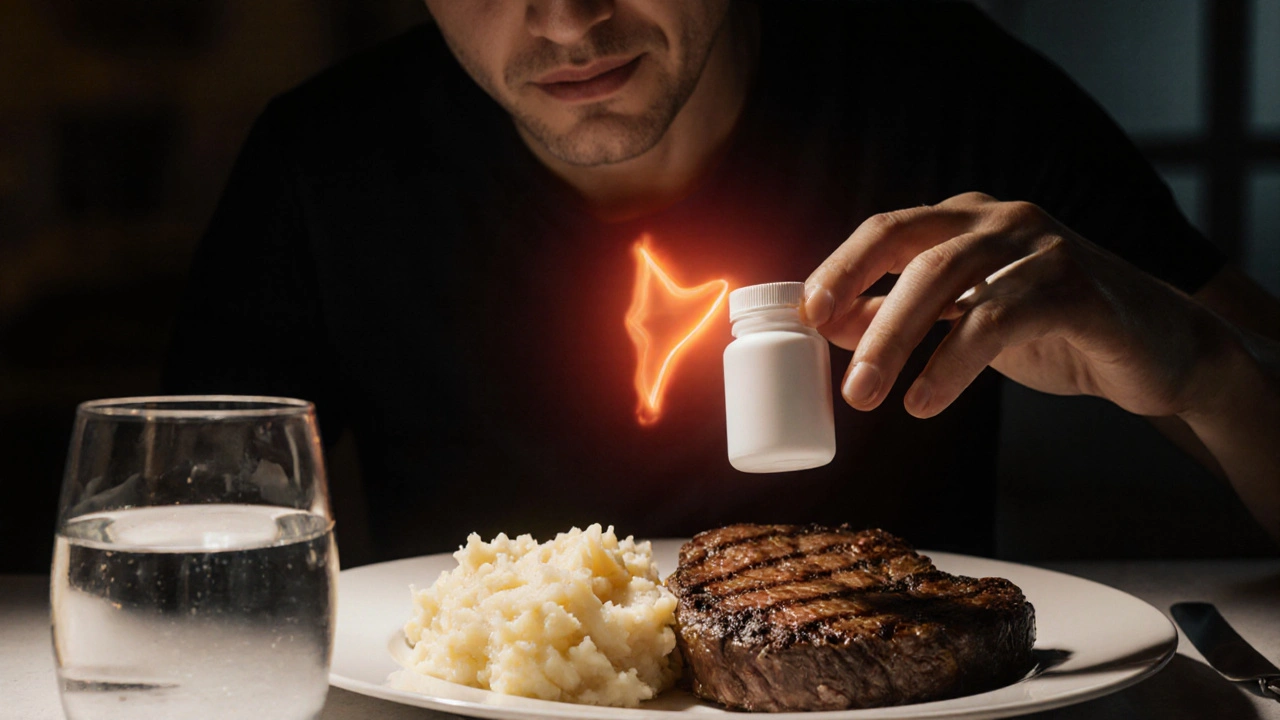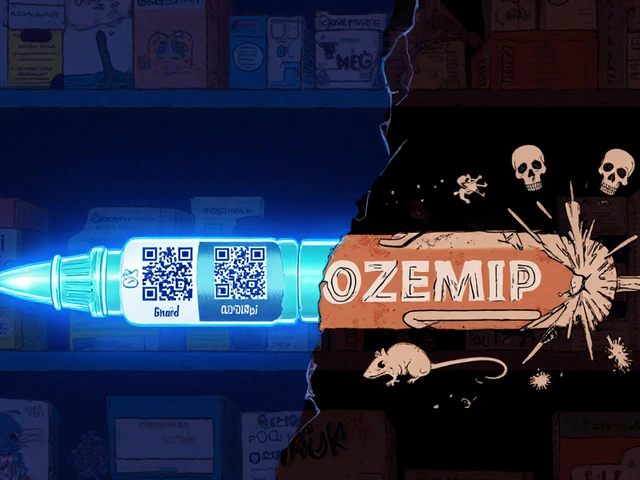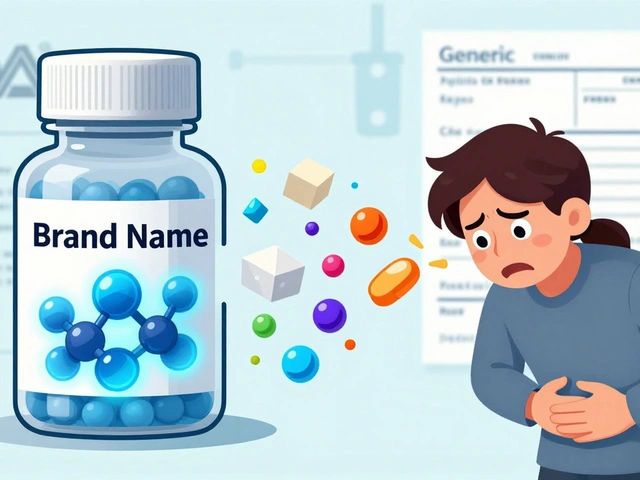Acid Reducer Decision Guide
Recommended Medication
Detailed Comparison
| Medication | Onset | Duration | Cost | Interaction Risk |
|---|
Key Takeaways
- Prevacid (lansoprazole) is a potent proton pump inhibitor (PPI) with once‑daily dosing and strong acid suppression.
- Omeprazole, esomeprazole, pantoprazole, rabeprazole, and dexlansoprazole provide similar efficacy but differ in cost, onset, and interaction profile.
- H2‑blockers (famotidine, ranitidine) and antacids (calcium carbonate) work faster but offer shorter relief, useful for occasional heartburn.
- Choosing the right drug depends on severity of GERD, timing of symptoms, price sensitivity, and any concomitant medications.
- All PPIs share potential long‑term risks such as nutrient malabsorption; short‑term use remains safe for most adults.
When you hear the name Prevacid, you probably picture a pill that quiets that burning feeling after a big meal. But how does it really stack up against the other options on the market? Below you’ll find a plain‑English breakdown that helps you decide whether Prevacid is the right fit or if another acid‑reducing medication might serve you better.
What is Prevacid (Lansoprazole)?
Prevacid is a prescription‑only proton pump inhibitor (PPI) whose active ingredient is lansoprazole. It works by irreversibly blocking the H+/K+ ATPase enzyme in the stomach’s parietal cells, effectively turning off the main source of gastric acid production.
Lansoprazole was approved by the FDA in 1995 and quickly gained a reputation for strong acid suppression, usually achieving a 90% reduction in basal acid output after just one dose. Typical dosing is 15-30mg once daily, taken before breakfast, although a twice‑daily regimen may be prescribed for severe ulcer disease.
How Proton Pump Inhibitors Work
PPIs, including Prevacid, target the final step of acid secretion. By inhibiting the proton pump, they lower the stomach’s pH for up to 24hours, allowing damaged esophageal tissue to heal and preventing new ulcer formation. Because they act on the pump itself-not just on histamine receptors-PPIs are more powerful than H2‑blockers, which only dampen one signaling pathway.
Main PPI Alternatives to Prevacid
While all PPIs share a core mechanism, each has unique pharmacokinetic quirks that affect how quickly they work, how long they last, and how they interact with other drugs.
- Omeprazole - the first PPI on the market; cheap generic options; onset within 1‑2hours; dose 20mg daily.
- Esomeprazole - the S‑enantiomer of omeprazole; marketed as Nexium; slightly higher bioavailability; often chosen for refractory GERD; dose 20‑40mg daily.
- Pantoprazole - stable in acidic environments; lower drug‑interaction risk; common in hospital IV formulations; dose 40mg daily.
- Rabeprazole - fastest onset among PPIs (about 1hour); useful for night‑time symptoms; dose 20mg daily.
- Dexlansoprazole - a dual‑delayed‑release formulation of lansoprazole; provides two separate releases over 24hours; dose 30mg daily; good for patients who miss doses.
Non‑PPI Options: H2‑Blockers & Antacids
When symptoms are mild or infrequent, faster‑acting agents may be sufficient.
- Famotidine - an H2‑blocker with a half‑life of about 2.5hours; dosage 20‑40mg twice daily; effective for nighttime heartburn.
- Ranitidine - formerly popular but withdrawn in many markets due to NDMA contamination concerns; still cited in older guidelines.
- Calcium carbonate (e.g., Tums) - antacid that neutralizes acid directly; works within minutes; dose varies by product strength; not suitable for chronic GERD.
Side‑Effect Profiles Compared
All PPIs, including Prevacid, share a class‑wide safety record: short‑term use (under 8 weeks) is considered low risk. However, long‑term therapy can lead to:
- Reduced magnesium and calcium absorption - potential bone‑density loss.
- Increased risk of Clostridioides difficile infection.
- Possible rebound acid hypersecretion after abrupt discontinuation.
H2‑blockers tend to cause fewer nutrient issues but can provoke headache, dizziness, or mild confusion, especially in the elderly. Antacids may cause constipation (calcium) or diarrhea (magnesium) if overused.
Comparison Table: Prevacid vs Common Alternatives
| Medication | Typical Dose | Onset of Relief | Duration of Action | Average Monthly Cost (US$) | Food Interaction |
|---|---|---|---|---|---|
| Prevacid (Lansoprazole) | 15‑30mg once daily | ≈2hours | ~24hours | 30‑45 | Take 30min before meal |
| Omeprazole | 20mg daily | 1‑2hours | ~24hours | 5‑15 (generic) | Take before breakfast |
| Esomeprazole | 20‑40mg daily | ≈1hour | ~24hours | 45‑70 (brand) | Take before meal |
| Pantoprazole | 40mg daily | ≈2hours | ~24hours | 25‑40 | Can be taken with or without food |
| Rabeprazole | 20mg daily | ≈1hour | ~24hours | 20‑35 | Take before meal |
| Dexlansoprazole (dual release) | 30mg daily | ≈2hours (first release) | ~24hours (second release) | 55‑80 | Take before breakfast |

Decision Criteria: Picking the Right Acid‑Reducer
- Efficacy for your condition - severe erosive esophagitis usually needs a strong, once‑daily PPI like Prevacid, esomeprazole, or dexlansoprazole.
- Speed of relief - if you need quick relief, an H2‑blocker (famotidine) or antacid can be added on‑demand.
- Cost considerations - generic omeprazole and lansoprazole are the most budget‑friendly; brand‑only options (esomeprazole, dexlansoprazole) cost more.
- Drug‑interaction risk - pantoprazole has the lowest CYP‑450 involvement, making it safer for patients on warfarin or antiretrovirals.
- Dosing convenience - once‑daily regimens improve adherence; dual‑release dexlansoprazole may be forgiving for missed doses.
Best‑Fit Scenarios
- Occasional heartburn - antacid (calcium carbonate) or famotidine as needed.
- Frequent mild‑to‑moderate reflux - generic omeprazole or lansoprazole; both inexpensive and effective.
- Severe GERD or Barrett’s esophagus - high‑dose esomeprazole or dexlansoprazole for sustained acid control.
- Nocturnal symptoms - rabeprazole or a bedtime dose of lansoprazole; they maintain low nighttime acidity.
- Patients on multiple meds (e.g., anticoagulants) - pantoprazole’s low interaction profile makes it a safer choice.
Practical Tips & Pitfalls to Avoid
- Never crush or chew PPIs; the protective coating ensures proper absorption in the intestine.
- Take the pill 30-60minutes before the first meal of the day for optimal effect.
- If you need to stop a PPI after long‑term use, taper down over 2-4 weeks to prevent rebound acid hypersecretion.
- Monitor vitamin B12, magnesium, and calcium levels annually if you’ve been on a PPI for more than a year.
- Inform your pharmacist about all supplements; some herbal products (e.g., St.John’s wort) can alter PPI metabolism.
Frequently Asked Questions
Is Prevacid stronger than Omeprazole?
Both drugs belong to the same class and achieve similar acid suppression when taken correctly. The perceived “strength” often comes from dosing convenience and individual metabolism. In practice, many patients find generic omeprazole works just as well for mild‑to‑moderate GERD, while Prevacid may be chosen for its slightly faster onset in ulcer healing.
Can I switch from Prevacid to an over‑the‑counter PPI?
Yes. Over‑the‑counter (OTC) versions of lansoprazole and omeprazole are available in 15‑mg and 20‑mg strengths. If you’ve been stable on Prevacid, a pharmacist can help you pick an equivalent OTC dose and advise on the timing.
How long is it safe to stay on a PPI?
Short‑term (up to 8 weeks) use is widely accepted as safe for most adults. For chronic conditions, physicians often reassess the need every 6‑12 months and may rotate to an H2‑blocker or step‑down therapy if symptoms are controlled.
Do PPIs interact with blood thinners?
Some PPIs (especially omeprazole and esomeprazole) can increase the blood level of warfarin, raising bleeding risk. Pantoprazole is the least likely to affect warfarin metabolism, so doctors may prefer it for patients on anticoagulants.
What should I do if I miss a dose of Prevacid?
Take the missed tablet as soon as you remember, unless it’s close to the time of your next dose. In that case, skip the missed one and resume the regular schedule-don’t double‑dose.
Bottom line: Prevacid (lansoprazole) holds its own among the PPI crowd, especially for patients who need strong, consistent acid suppression. But the “best” choice always depends on your symptom pattern, budget, and any other meds you take. Use this guide to talk with your healthcare provider and land on the option that keeps your stomach calm without unnecessary side effects.





October 9, 2025 AT 13:21 PM
If you’re weighing Prevacid against the rest of the PPI lineup, start with the basics: onset, duration, cost, and drug‑interaction profile. Prevacid clocks in at about a two‑hour onset and holds the acid down for a full 24‑hour window, which is solid for most moderate GERD cases. Its price sits in the $30‑45 a month range-higher than generic omeprazole but lower than brand‑only esomeprazole. Interaction risk is low, though it does dip into CYP‑2C19 pathways, so watch any meds that share that route. Bottom line, it’s a reliable middle‑ground option when you need potency without breaking the bank.
October 20, 2025 AT 18:58 PM
Let’s unpack why that “middle‑ground” label isn’t just a marketing fluff. First, the pharmacodynamics of lansoprazole give it a slightly more consistent pH elevation compared to omeprazole, which can be a lifesaver for patients with nocturnal reflux that wakes them up in a cold sweat. Second, the once‑daily dosing aligns nicely with the body’s circadian rhythm, meaning you’re not battling a midnight surge of acid when the drug’s plasma levels are already tapering off. Third, while the cost sits above the cheapest generics, insurance formularies often negotiate down to a sweet spot that makes it comparable to a two‑month supply of generic omeprazole, especially when you factor in the reduced need for rescue antacids. Fourth, the interaction profile, albeit low, still warrants a quick glance at the CYP‑450 map-if you’re on clopidogrel or certain antivirals, you might need to pivot to pantoprazole instead. Fifth, the safety data over the past decade reinforce that short‑term use (under eight weeks) carries minimal risk of nutrient malabsorption, which is a common scare in online forums. Sixth, the rebound acid hypersecretion phenomenon after abrupt discontinuation is real, but tapering the dose over two to four weeks smooths the transition. Seventh, for ulcer healing, the two‑hour onset is clinically acceptable; faster‑onset agents like rabeprazole might shave off an hour, but the overall healing timeline isn’t dramatically different. Eighth, the pill’s enteric coating is not just a gimmick-it protects the drug from the acidic stomach environment, ensuring it reaches the intestine where absorption is optimal. Ninth, real‑world adherence data show that patients on lansoprazole have a marginally higher continuation rate than those on omeprazole, suggesting a subtle satisfaction edge. Tenth, the side‑effect profile is comparable across the PPI class, with headache and mild gastrointestinal upset being the most common complaints. Eleventh, if you’re juggling multiple prescriptions, the low interaction risk places Prevacid ahead of some of its peers, which can inhibit the metabolism of drugs like diazepam. Twelfth, the brand’s patient‑education resources, including dosing timers and dietary tips, can improve outcomes for DIY health enthusiasts. Thirteenth, the FDA’s post‑marketing surveillance hasn’t flagged any unique safety signals for lansoprazole that would set it apart from the class. Fourteenth, the data on long‑term bone density effects remain mixed, but using the lowest effective dose mitigates that concern. Finally, in the grand scheme of acid‑reducing therapy, Prevacid offers a balanced blend of efficacy, convenience, and cost that makes it a worthy contender for many patients seeking relief without diving into the premium tier.
November 1, 2025 AT 00:36 AM
For occasional heartburn, a cheap antacid works fine. No need to jump to a PPI unless symptoms are frequent.
November 12, 2025 AT 06:13 AM
Occasional symptoms often slip under the radar of heavy‑duty meds. An H2‑blocker like famotidine can give you quick relief without the long‑term baggage of PPIs. It’s also easy on the wallet, which matters for many. Just remember to avoid taking it too close to bedtime if you’re prone to night‑time reflux.
November 23, 2025 AT 11:51 AM
When you’re choosing between Prevacid and its cousins, consider how often you need the acid suppression. If you’re dealing with mild to moderate reflux a few times a week, generic omeprazole or lansoprazole gives you a solid bang for your buck. On the other hand, if you’ve got severe erosive esophagitis, stepping up to esomeprazole or dexlansoprazole might shave off some weeks from the healing timeline. Cost‑sensitivity is a real factor too – a bottle of generic omeprazole can be as low as $5, while brand‑only options can climb past $70. Interaction risk matters if you’re on anticoagulants; pantoprazole is often the safest pick. Finally, think about dosing convenience – once‑daily pills are easier to remember than a twice‑daily regimen, which can make the difference between adherence and abandonment.
December 4, 2025 AT 17:29 PM
Great points. I’d add that many pharmacies now offer a 30‑day supply for under $10 if you ask for the generic. That can ease the cost burden.